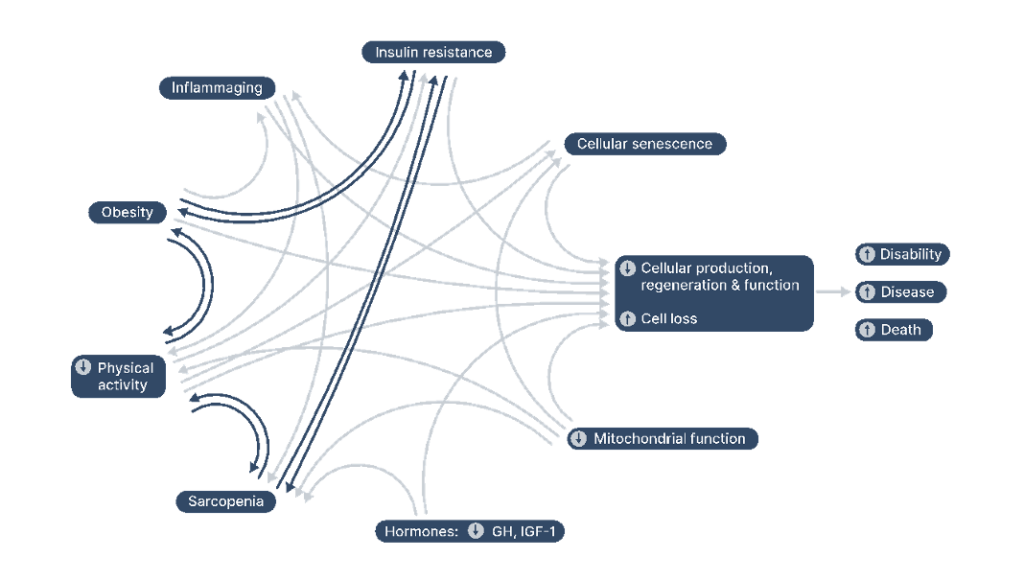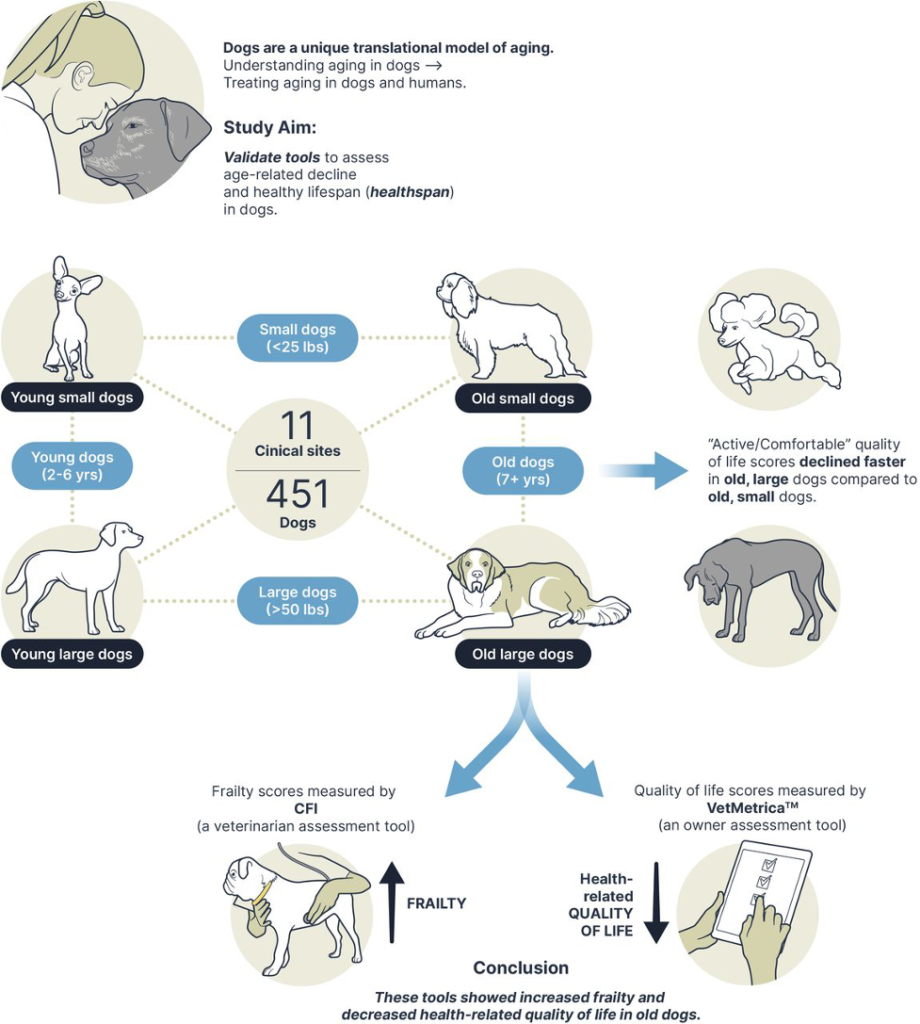As you may have noticed, my productivity in writing blog posts has declined significantly this year. A large part of the reason is that I have been spending my time writing scientific publications and preparing continuing education talks for veterinary conferences, all on subjects related to canine aging.
This post is intended to highlight the scientific articles I have written or worked on this year. Hopefully, this will be an interesting introduction to the field of canine aging and the potential for legitimate scientific interventions which can be shown to meaningfully impact aging and the negative health outcomes associated with it.
Currently, most of the advice pet owners receive about aging is unproven or pseudoscientific and unlikely to truly improve the welfare of their pets. Real science is often more nuanced and complex and less sexy and satisfying than pseudoscience due to the frustrating limits set by fidelity to actual scientific evidence. Still, the field of geroscience is a an exciting point where there is the potential to begin translating decades of lab research into clinically useful therapies. As always, we must proportion our confidence (and excitement) to the level of evidence, and we have a long way to go before we can confidently say that Drug X or Practice y will extend your dog’s health span or lifespan. But there is a path forward to doing this, and these articles are my small part in helping to pave that path.
- McKenzie BA, Chen FL. Assessment and Management of Declining Physical Function in Aging Dogs. Top Companion Anim Med. 2022 Oct 21;51:100732. doi: 10.1016/j.tcam.2022.100732. Epub ahead of print. PMID: 36273752.
Aging is the leading cause of disability, disease, and death in adult dogs. One major consequence of aging is diminishing physical function. In humans, there are validated clinical assessments of physical function that can predict disability, morbidity, and mortality. There are also effective interventions to preserve and restore function and reduce the risk of death and disease in the elderly. This review evaluates the decline in physical function with age in dogs and the potential utility in this species of clinical assessment tools and interventions developed for humans.

2. McKenzie, BA. Lacroix-Fralish, ML. Chen, F. The phenotype of aging in the dog: How aging impacts the health and wellbeing of dogs and their caregivers. J Amer Vet Med Assoc. 2022;260(9):963-970. https://doi.org/10.2460/javma.22.02.0088
Contrary to the common view of aging as a mysterious and inevitable natural event, it is more usefully understood as a set of complex but comprehensible biological processes that are highly conserved across species. Although the expression of these processes is variable, there are consistent patterns both within and between species. The purpose of this review is to describe the patterns currently recognized in the physical and behavioral manifestations of aging in the dog and how these impact the health and welfare of companion dogs and their human caregivers. This will set the context for future efforts to develop clinical assessments and treatments to mitigate the negative impact of aging on dogs and humans.

3. McKenzie, BA. Comparative Veterinary Geroscience: Mechanism of molecular, cellular, and tissue aging in humans, laboratory animal models, and companion dogs and cats. Amer J Vet Res. 2022;83(6): https://doi.org/10.2460/ajvr.22.02.0027.
The purpose of this review is to describe key mechanisms of aging at the cellular and molecular level and the manifestations of these in the tissues of the musculoskeletal system, adipose, and the brain. This will highlight knowledge gaps and important targets for future research to extend lifespan and healthspan in dogs and cats.

4. McKenzie, BA. Chen, FL. Gruen, ME. Olby, NJ. Canine Geriatric Syndrome: A Framework for Advancing Research in Veterinary Geroscience . Front Vet Sci. 2022;21(9):853743. 10.3389/fvets.2022.853743
In this paper we propose a new conceptual framework for aging in dogs, the Canine Geriatric Syndrome (CGS). CGS consists of the multiple, interrelated physical, functional, behavioral, and metabolic changes that characterize canine aging as well as the resulting clinical manifestations, including frailty, diminished quality of life, and age-associated disease. We also identify potential key components of a CGS assessment tool, a clinical instrument that would enable veterinarians to diagnose CGS and would facilitate the development and testing of interventions to prolong healthspan and lifespan in dogs by directly targeting the biological mechanisms of aging.

5. Chen FL. Ullal TV. Graves Jl. Ratcliff ER. Naka A. McKenzie BA. Carttar TA. Super KM. Austriaco J. Weber SY. LaCroix-Fralish ML. Vaughn J. Evaluating instruments for assessing healthspan: a multi-center cross-sectional study on health-related quality of life (HRQL) and frailty in the companion dog. bioRxiv 2022.07.21.500746; doi: https://doi.org/10.1101/2022.07.21.500746
Developing valid tools that assess key determinants of canine healthspan such as frailty and health-related quality of life (HRQL) is essential to characterizing and understanding aging in dogs. Additionally, because the companion dog is an excellent translational model for humans, such tools can be applied to evaluate gerotherapeutics and investigate mechanisms underlying longevity in both dogs and humans. In this study, we investigated the use of a clinical questionnaire (Canine Frailty Index; CFI; Banzato et al., 2019) to assess frailty and an owner assessment tool (VetMetrica HRQL) to evaluate HRQL in adult companion dogs.











I refuse to admit how long it took me to realize that “geoscience” was a typo and this was not about some new shiny geology-driven treatment for age related disease. But it may be advantageous to fix. 😉
(Great content as usual!)
Dear Skepvet, if we don’t effectively tackle the human problem that is causing our planet and other then human life life upon it to moan and groan, the ageing of dogs won’t matter.
That said, careful breeding, feeding ( commented on feeding on the vegan thread) and general overall care seems to have a large impact on longevity. It’s been my interest and over the years, the average enjoyable life expectancy of my many dogs has risen from just under 14 to 15 1/2. My last four dying of old age, 3 at 16 and one at 17 1/2.
Of course humanity faces multiple challenges, but we all have to choose a focus based on our interests and abilities. Trying to reduce suffering and improve life ford dogs doesn’t imply a lack of interest in other pressing issues.
There are lots of potential targets for intervention to extend health span and lifespan, from lifestyle and nutrition to medicines. The devil, as always, is in the details and the data, and every plausible hypothesis needs to be tested and refined. Doing that is the best path to longer, happier lives for our dogs and ourselves.
Pingback: 2022 Publications in Canine Aging | - Animal Blog